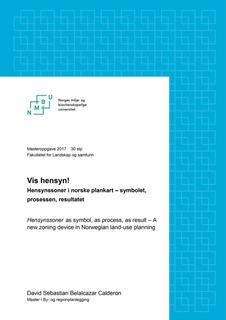| dc.contributor.advisor | Grønning, Marius | |
| dc.contributor.author | Belalcazar Calderon, David Sebastian | |
| dc.coverage.spatial | Norway | nb_NO |
| dc.date.accessioned | 2017-09-19T13:14:14Z | |
| dc.date.available | 2017-09-19T13:14:14Z | |
| dc.date.issued | 2017 | |
| dc.identifier.uri | http://hdl.handle.net/11250/2455539 | |
| dc.description.abstract | Hensynssoner er et nytt kommunalt planleggingsverktøy og kartsymbol som ble innført med plan- og bygningsloven av 2008. Hensynssoner fremvises hovedsakelig i kommuneplanens arealdel, men kan også anvendes i områderegulering og detaljregulering. Formålet med denne oppgaven er å identifisere og forstå hensikten bak innføringen av hensynssoner, vurdere sterke og svake sider av dette planleggingsverktøyet, og vise noen prinsipper for en riktig implementering av det. På denne måten kan oppgaven være en del av utforskningen av det norske plansystemet, og utfylle eksisterende retningslinjer om bruk av dette verktøyet.
Å utforske på hensikten bak innføringen av hensynssoner, samt praktiseringen av dette verktøyet, innebærer flere rammer for forståelse. Først av alt snakker vi om et kartsymbol, og må regnes som sådan blant andre kartelementer. Videre, gjennom dokumentstudier av plan- og bygningsloven og tidligere planlover, samt forarbeidene til disse, klargjør en historisk analyse nye funksjoner som hensynssoner tilbyr det norske planleggingssystemet. Til slutt, gjennom en kvalitativ analyse basert på intervjuer og dagens kommuneplaner, viser oppgaven en komparativ eksempelstudie av Bærum og Tromsø kommune. Studien gir et innblikk i anvendelsen av hensynssoner i kommuneplanens arealdel.
Den teoretiske rammen for denne oppgaven består av en rekke temaer som går ut på forståelse av kart og kartsymbol i planlegging, formalisering av juridisk bindende dokumenter, funksjoner og virkemidler i planlegging, og institusjonalisering.
Oppgaven viser at hensynssoner er et planleggingsverktøy som har flere antecedente i tidligere lover i form av bestemmelser, areal- eller reguleringsformål. Samtidig viser oppgaven at hensynssoner ikke har en bestemt funksjon, men en rekke funksjoner i det norske plansystemet: De fungerer som et kommunikativ middel mellom kommunen, sektorer og andre planaktører, og gir kontroll over resultater og planleggingsprosesser. Vi snakker om et nyttig verktøy, men som må anvendes på en riktig måte, da en aktiv bruk av hensynssoner vil medføre til kompliserte og uleselige plankart. | nb_NO |
| dc.description.abstract | Hensynssoner is a new zoning instrument in Norwegian land-use planning, introduced through the Norwegian Planning and Building Act of 2008. It is mainly used for the land-use component of the municipal development plan (kommuneplanens arealdel), but can also be used for more detailed plans such as area regulation (områderegulering) or detailed regulation (detaljregulering). The aim of this study is to identify and understand the intentions and arguments that lead to the new instrument, to assess some strengths and weaknesses, and indicate some principles of good practice. In this sense, it can be part of a general research basis for the Norwegian planning system, and maybe complement existing instruction guidelines for planners. Addressing the intention behind the introduction of hensynssoner, as well as the practice of this new tool, involves several frames of understanding. First of all, it is a map symbol, and must be accounted for as such, among other cartographic elements. Furthermore, through document studies of successive planning laws and their preparatory reports, an historical analysis clarifies new functions that the new zoning instrument is offering the Norwegian planning system. Finally, through qualitative analysis based on interviews and present day plans, a comparative example study of the municipalities of Bærum and Tromsø is carried out. Altogether these operations provide an insight to the early experiences with applying the new planning tool in the field of municipal land-use plans. The thesis builds its theoretical framework on a number of themes, such as the understanding of maps and map symbols in planning, functions and tools in spatial planning, and processes of institutionalization, and, not the least, the role of legally binding documents as well as their formalizing effect on graphical language. The study shows that the new zoning instrument has precedents in earlier planning legislation, in the form of statutory provision, land-use components of the municipal development plan, or land-use categories in regulation plans. It also shows, interestingly, that the new tool does not have one unique function, but a number of planning functions: it acts as a means of communication between the sectors, stakeholders, and the municipal land-use authority, it provides different forms of control over planning process and also over the substantial content of the plan. Hence, it is a useful tool, but an ambiguous one which can create confusion. An active use of it may therefore lead to complicated, unreadable, even unreliable land-use plans. With this risk in mind, the use of hensynssoner requires a degree of consciousness that basic instructions alone do not provide. | nb_NO |
| dc.language.iso | nob | nb_NO |
| dc.publisher | Norwegian University of Life Sciences, Ås | nb_NO |
| dc.rights | Navngivelse 4.0 Internasjonal | * |
| dc.rights.uri | http://creativecommons.org/licenses/by/4.0/deed.no | * |
| dc.subject | Plan- og bygningsloven | nb_NO |
| dc.title | Vis hensyn : hensynssoner i norske plankart : symbolet, prosessen, resultatet | nb_NO |
| dc.title.alternative | Hensynssoner as symbol, as process, as result : a new zoning device in Norwegian land-use planning | nb_NO |
| dc.type | Master thesis | nb_NO |
| dc.subject.nsi | VDP::Samfunnsvitenskap: 200 | nb_NO |
| dc.source.pagenumber | 153 | nb_NO |
| dc.description.localcode | M-BYREG | nb_NO |

